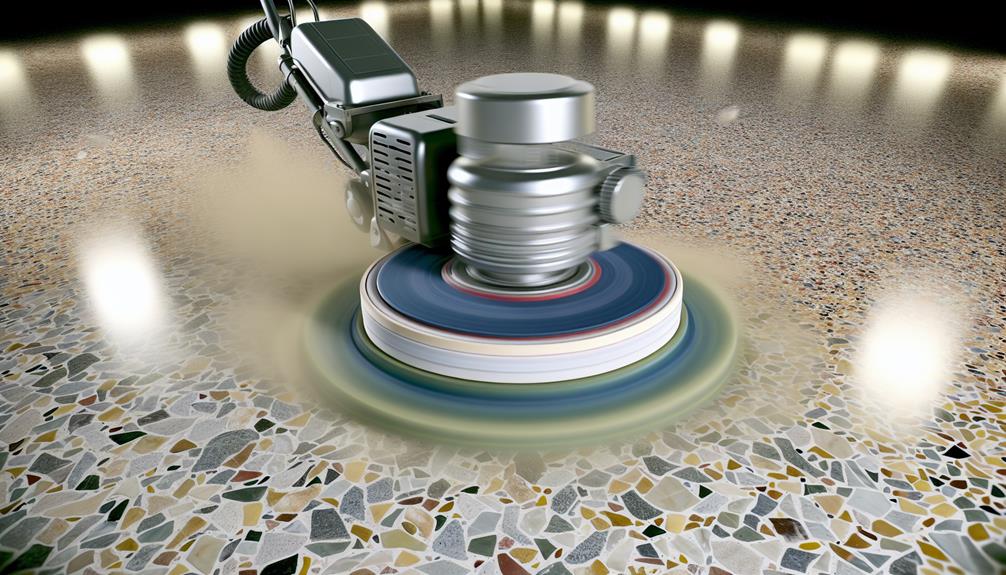Embark on a journey towards mastering the art of terrazzo polishing, where each step unveils the key to achieving a flawless finish that will stand the test of time. Uncover the secrets behind recognizing the nuances of aggregate composition and the intricate dance of selecting the perfect tools for the job. As you navigate through the complexities of the polishing process, a world of possibilities awaits, promising a gleaming terrazzo surface that exudes elegance and sophistication.
Key Takeaways
Contents
- 1 Key Takeaways
- 2 Understanding Terrazzo Surfaces
- 3 Preparing the Surface for Polishing
- 4 Necessary Tools and Equipment
- 5 Selecting the Right Polishing Pads
- 6 Step-by-Step Polishing Process
- 7 Achieving a Glossy Finish
- 8 Sealing and Protecting the Terrazzo
- 9 Maintenance Tips for Longevity
- 10 Troubleshooting Common Polishing Issues
- 11 Frequently Asked Questions
- Clean and repair terrazzo before polishing to ensure a smooth surface.
- Use diamond grinding pads of varying grits for effective polishing.
- Apply polishing compounds in circular motions for a glossy finish.
- Seal the terrazzo surface to protect against stains and etching.
- Maintain terrazzo with regular cleaning, sealing, and periodic polishing.
Understanding Terrazzo Surfaces
Terrazzo surfaces are a unique and durable flooring option that can bring elegance and sophistication to any space.
Understanding the intricacies of terrazzo is essential for achieving a flawless polishing result. Terrazzo consists of a mixture of marble, quartz, granite, glass, or other suitable chips embedded in a cementitious or epoxy binder.
The surface is then ground and polished to reveal a smooth and seamless finish that showcases the beauty of the aggregates.
To truly master terrazzo polishing, you must be familiar with the different types of terrazzo, such as traditional terrazzo, rustic terrazzo, and palladiana terrazzo.
Each type requires specific techniques and tools for polishing to enhance its unique characteristics. Additionally, recognizing the aggregate composition of the terrazzo mix is crucial for determining the appropriate polishing methods and products to use.
Preparing the Surface for Polishing
To achieve a flawless polishing result on terrazzo surfaces, meticulous preparation of the surface is paramount.
This involves several crucial steps that must be followed carefully to ensure a perfect finish.
1. Cleaning: Begin by thoroughly cleaning the terrazzo surface to remove any dirt, debris, or residues.
Use a neutral pH cleaner and a soft-bristle brush to avoid damaging the surface.
2. Repairing: Inspect the terrazzo for any cracks, chips, or damage.
Repair these imperfections using an appropriate terrazzo repair compound that matches the color and texture of the existing surface.
3. Grinding: Utilize a coarse diamond grinding pad to level the surface and remove any uneven areas.
This step is crucial for achieving a uniform and smooth finish during the polishing process.
4. Filling: Fill any voids or pinholes in the terrazzo with a matching epoxy filler.
This will ensure a seamless surface that's ready for polishing to a brilliant shine.
Necessary Tools and Equipment
For the successful polishing of terrazzo surfaces, having the right tools and equipment is key.
To achieve a professional finish, you'll need a floor grinder equipped with diamond grinding pads. These pads come in various grit levels, from coarse to fine, for different stages of the polishing process.
Additionally, a wet/dry vacuum is essential to keep the work area clean and free of debris during polishing.
You'll also require a set of diamond polishing pads, ranging from 50 grit to 3000 grit, to achieve the desired level of shine on the terrazzo surface.
Other necessary tools include a burnishing machine for the final polishing stage, along with a mop and bucket for cleaning the surface before and after polishing.
It's crucial to have safety equipment such as goggles, gloves, and a dust mask to protect yourself during the polishing process.
With the right tools and equipment in hand, you can master the art of terrazzo polishing and achieve exceptional results.
Selecting the Right Polishing Pads
When selecting the right polishing pads for your terrazzo polishing project, it's crucial to consider the specific requirements of the surface and the desired level of shine.
Achieving the perfect polish requires the right tools.
Here are some key factors to keep in mind:
1. Grit Level: Choose pads with the appropriate grit level based on the condition of your terrazzo.
Lower grits are ideal for initial grinding to remove imperfections, while higher grits are used for achieving a glossy finish.
2. Pad Material: Opt for high-quality pads made from materials like diamond, resin, or ceramics.
These materials offer durability and effective polishing performance.
3. Pad Size: Select pads in various sizes to ensure you can reach all areas of the terrazzo surface, including corners and edges.
4. Pad Thickness: Consider the thickness of the pads as it can impact the pressure applied during polishing.
Thicker pads provide more stability and last longer, while thinner pads offer more flexibility for intricate detailing.
Step-by-Step Polishing Process
As you embark on the terrazzo polishing journey, understanding the step-by-step polishing process is essential for achieving a flawless finish.
Follow this detailed guide to ensure precision and expertise in your terrazzo polishing project:
Step-by-Step Polishing Process
1. Surface Preparation
Clean the surface thoroughly.
Repair any cracks or damages.
Ensure the surface is dry before proceeding.
2. Grinding
Begin with a low-grit diamond pad.
Progress to higher grits for a smoother finish.
Keep the machine moving in a consistent pattern.
3. Honing
Switch to resin-bonded diamond pads.
Continue with progressively finer grits.
Maintain a steady pace to avoid inconsistencies.
4. Polishing
Use a polishing powder or cream.
Work in circular motions for an even shine.
Repeat until the desired level of gloss is achieved.
5. Sealing
Apply a terrazzo sealant to protect the surface.
Follow manufacturer's instructions for drying times.
Achieving a Glossy Finish
To enhance the terrazzo's visual appeal and durability, achieving a glossy finish is paramount.
Achieving a stunning glossy finish on your terrazzo surface requires careful attention to detail.
1. Diamond Grinding: Begin the polishing process with diamond grinding to remove any surface imperfections and level the terrazzo floor.
This step is essential for creating a smooth base for the glossy finish.
2. Honing: After diamond grinding, honing the terrazzo surface helps further refine it.
This step involves using progressively finer grits of abrasives to smoothen the surface and prepare it for polishing.
3. Polishing: Utilize a quality polishing compound and equipment to bring out the natural shine of the terrazzo.
The polishing process involves multiple passes with increasingly finer grits to achieve a glossy finish.
4. Buffing: Finally, buff the terrazzo surface to enhance the shine and smooth out any remaining imperfections.
This step adds a final touch of glossiness, leaving your terrazzo floor looking immaculate and elegant.
Sealing and Protecting the Terrazzo
For proper maintenance and longevity of your terrazzo surface, sealing and protecting the terrazzo is crucial.
Sealing your terrazzo helps to prevent staining and etching by creating a protective barrier against spills and other damaging substances.
It also enhances the color and shine of the terrazzo, providing a polished and pristine appearance.
To effectively seal your terrazzo, start by thoroughly cleaning the surface to remove any dirt, dust, or debris.
Once the surface is clean and dry, apply a high-quality terrazzo sealer using a clean mop or applicator brush, ensuring even coverage.
Allow the sealer to dry completely before applying a second coat for added protection.
Regularly maintaining the sealed terrazzo by cleaning up spills promptly and using gentle, pH-neutral cleaners will help prolong the life of the sealant and keep your terrazzo looking its best.
Periodically check the sealant for wear and tear, and reapply the sealer as needed to maintain optimal protection and longevity for your terrazzo surface.
Maintenance Tips for Longevity
Regular maintenance is essential for preserving the longevity and appearance of your terrazzo surface.
To ensure your terrazzo stays in top condition, follow these expert maintenance tips:
- Daily Cleaning: Sweep or vacuum the surface daily to remove dirt and debris that can scratch the terrazzo when walked on.
- Weekly Mopping: Use a pH-neutral cleaner and a damp mop to clean the terrazzo weekly. Avoid harsh chemicals that can damage the surface.
- Periodic Polishing: Depending on foot traffic, consider periodic polishing to maintain the shine and smoothness of the terrazzo. This can be done every few months or as needed.
- Professional Maintenance: Schedule regular professional maintenance to address any deep stains, scratches, or wear and tear that may require specialized equipment and expertise.
Troubleshooting Common Polishing Issues
Maintaining the longevity and shine of your terrazzo surface requires attention to detail and proactive care.
When troubleshooting common polishing issues, it's crucial to identify the root cause accurately. Dull spots may indicate inadequate diamond grit progression during the polishing process. Address this by going back to a lower grit to refine the surface properly before progressing to higher grits.
If streaks or swirl marks appear, reassess your polishing technique, ensuring consistent pressure and movement. Pitting or uneven surfaces could result from improper densification or resin application. In such cases, consult with a terrazzo professional to assess and correct the issue effectively.
Efflorescence, the appearance of white mineral salt deposits, signals moisture-related concerns. Identify and eliminate the source of moisture before addressing the efflorescence on the surface.
Frequently Asked Questions
Can Terrazzo Be Polished in Outdoor Spaces?
Yes, terrazzo can be polished in outdoor spaces. Ensure the surface is properly sealed to resist weathering. Use diamond polishing pads with a progressively finer grit. Finish with a penetrating sealer for lasting protection against the elements.
Is It Safe to Use Chemical Cleaners on Polished Terrazzo?
It's safe to use chemical cleaners on polished terrazzo, but choose pH-neutral options to preserve the surface. Be cautious of harsh chemicals that can damage the shine. Always test cleaners in a small, inconspicuous area first.
Can Terrazzo Be Polished to a Matte Finish?
Yes, terrazzo can be polished to a matte finish. Achieving this requires specialized techniques and tools to carefully grind and hone the surface to the desired level of sheen. Professional expertise ensures a flawless matte finish.
How Long Does a Polished Terrazzo Floor Last?
To achieve a lasting terrazzo floor, dedication is key. Properly maintained with routine cleaning and periodic resealing, a polished terrazzo floor can withstand decades. Your commitment to upkeep ensures a beautiful and durable surface.
Can Terrazzo Be Polished Over Existing Tile or Hardwood Floors?
Yes, terrazzo can be polished over existing tile or hardwood floors. The process involves grinding down the existing surface to create a suitable base for the terrazzo. Professional expertise ensures a seamless transition and a durable finish.

